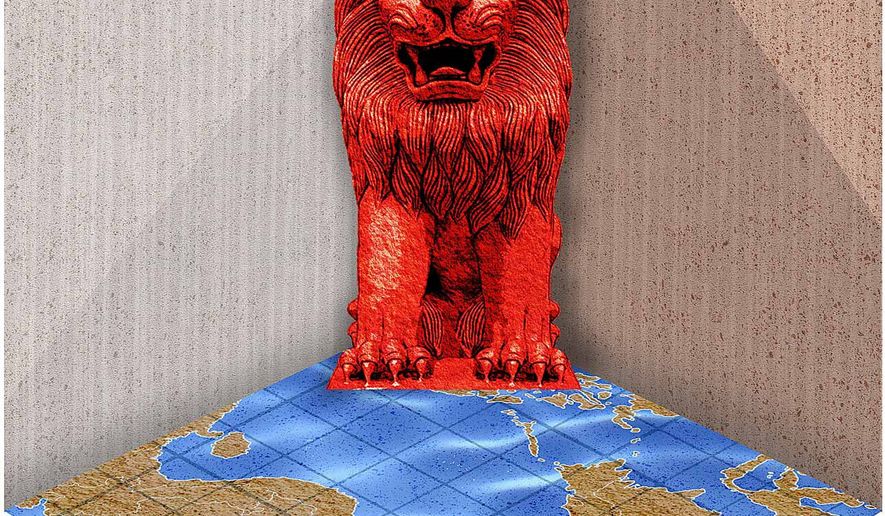OPINION:
Dec. 8 marked the 10th anniversary of Beijing’s operational abandonment of China’s “Charm Offensive” in its maritime strategy.
China’s offensively grasping maritime policies resemble China’s offensively grasping trade and economic policies, and unsurprisingly, the results are similar — they succeeded until the world woke up to Beijing’s designs and began pushing back.
Beijing’s strategists squandered a favorable maritime environment when on Dec. 8, 2008, 10 years ago, Beijing elected to begin seizing its neighbors’ maritime rights instead of developing sustainable and regionally cooperative maritime policies.
Rather than collaborate with its neighbors for secure, universally accepted maritime boundaries, Beijing instead chose to pursue regional maritime dominance, a strategy that prompted its neighbors to develop their own navies and appeal to outside powers.
The PRC was dealt a straight flush in its modern maritime environment. East Asia has not seen naval warfare in 40 years; the last naval combat in the region was in 1988, when a Chinese People’s Liberation Army naval task force posing as a UNESCO research expedition massacred 62 Vietnamese sailors at Chigua Reef. The region’s stable trade routes imposed no obligation upon the PLA to build its naval forces. China could have continued to develop with little investment in maritime forces apart from the fisheries regulation, port management and waterway safety bureaucracies of its unarmed Fisheries Bureau and Maritime Safety Administration.
Instead, Beijing overplayed its good hand by doubling down on the PLA’s 1988 massacre, establishing six outposts on Vietnam-claimed reefs. In 1995, as the United States departed the Philippines, the PLA naval infantry built and occupied an outpost on Mischief Reef inside the Philippines Exclusive Economic Zone, calling it a “fisheries rescue station.” No fisheries rescues were performed.
Tensions abated in 2002 when the PRC signed a declaration with its Asian neighbors promising not to further “complicate or escalate the disputes.” By 2006 China’s “Charm Offensive,” essentially a policy of declining to provoke its neighbors, had earned China a deep well of regional trust.
Meanwhile, China’s leadership had been deliberating new maritime policies appropriate to the regional leader it was becoming, incorporating input from domestic stakeholders in security, hydrocarbon, fisheries and marine safety sectors. On July 22, 2006, China’s State Council chose its path — the worst one. Beijing approved a proposal for a “Maritime Rights Defense” campaign, a euphemism for expanding its dominion at the expense of its neighbors over three million square kilometers of sea.
Communist Party organs validated the new approach. Propaganda outlets cherry-picked China’s history to fabricate fantastic mythologies of a China that once ruled East Asian waters. Maritime officials promised energy security with inflated estimates of offshore oil and gas China would “recover” from its neighbors. Party lawyers contrived queer quasi-legal justifications, arguing China’s vastness conveyed “rights” to proportionately vast seas, without regard for settled international law, other nations’ claims, or how China came by much of its vastness via invasions of Tibet and Xinjiang.
Although the State Council approved the new policy in 2006, it delayed execution until other potential complications had been resolved. The Communist Party anticipated that Taiwan elections, expected separatist uprisings and vulnerabilities to China’s prestige associated with the Beijing Olympics would make 2008 an unusually dangerous year. Apart from Vietnam, China’s leaders ordered that PRC maritime forces would not begin aggressing its neighbors until after the perceived hazards of 2008 were well behind it.
Four months after the closing ceremonies of the Beijing Olympics, 10 years ago this month, two Chinese government cutters sailed from Shanghai, circumnavigated Japan’s Senkaku Islands which China had begun to claim in the late 1960s, and returned to port. Triumphant video of the mission ran that same night on state-controlled evening news.
They had never done that before. Though legal, it was a deliberate and provocative operational challenge to Japan, the end of “charm” at sea. It marked the beginning of China’s maritime expansion campaign which continues to this day.
The subsequent expansionism has eroded the region’s trust in Beijing. It has motivated China’s neighbors to beseech the United States, Japan, Australia, India and European nations for support. The cost of China’s naval expansion has become debilitating now that governmental revenue growth is abating, and to date the PRC has produced zero offshore hydrocarbons from the excessive claims beyond its internationally recognized Exclusive Economic Zone. China’s contentiousness has, however, prevented its neighbors from fully exploiting their coastal resources which means China can’t even buy the oil at any price.
It didn’t have to be this way. Neither history nor geography dealt China this hand. China could already be the accepted and unchallenged regional maritime leader in East Asia had it decided to continue its Charm Offensive and implemented lawful maritime policies that accommodated and respected its neighbors’ sovereignties. Instead, as with its trade and economic policies, China chose to consider itself exempt from global rules and norms, with similar consequences.
• Bernard Moreland is a civilian employee of the U.S. Pacific Fleet. He formerly served as the U.S. Coast Guard Liaison Officer to China. These are his views and were not coordinated with the U.S. government.




Please read our comment policy before commenting.